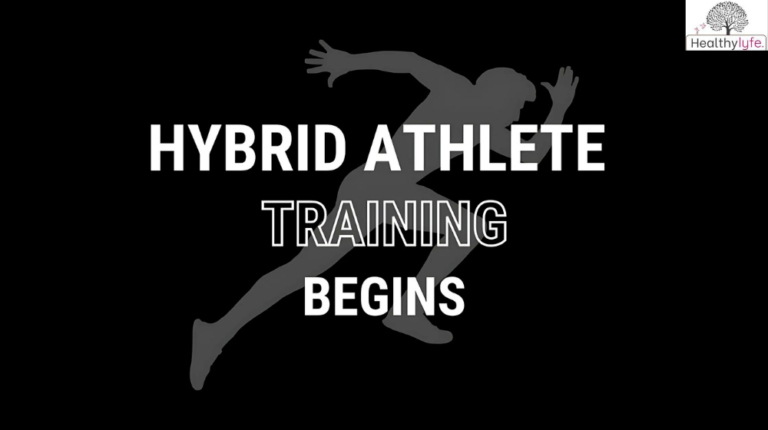Hybrid Fitness: A guide to balanced training that combines strength and cardio for optimal performance and overall wellness.
Introduction
Hybrid Fitness is a flexible and well-rounded approach to staying fit by combining different types of exercise. In today’s busy world, many people are looking for workouts that offer a balance of strength, endurance, flexibility, and recovery. Hybrid Fitness brings together various training methods—like strength training, cardio, functional movements, and stretching—to create a comprehensive fitness plan that works for everyone.
This guide will explore how blending different workout styles can help you achieve your fitness goals in a more effective and sustainable way. Whether you’re just starting out or already into fitness, Hybrid Fitness allows you to create a personalized training plan that fits your needs and keeps you moving forward. With a mix of proven techniques and practical tips, Hybrid Fitness helps you stay motivated and see lasting results.
What is Hybrid Fitness?
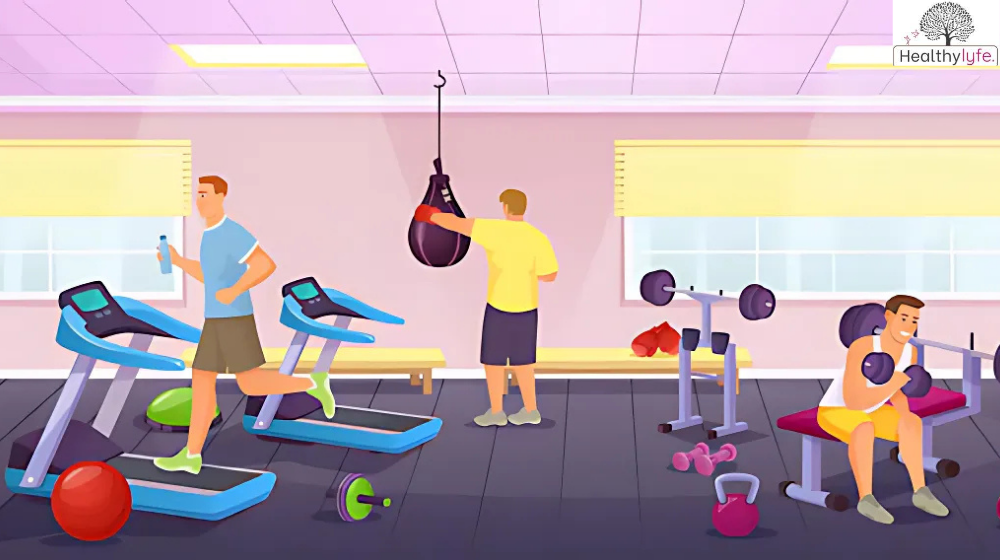
Hybrid Fitness is a fun and well-rounded approach to exercise that combines different types of workouts into one complete routine. It blends strength training, cardio, functional movements, flexibility, and recovery to create a balanced fitness plan.
The idea behind Hybrid Fitness is to mix various training styles so you can improve not just your physical strength, but also your endurance, flexibility, and overall well-being. By combining these different elements, you get a more complete and effective workout that keeps things interesting and helps you reach your fitness goals.
Key Parts of Hybrid Fitness:
- Strength Training – Building muscle and boosting overall power.
- Cardio – Improving your endurance and heart health.
- Functional Movement – Enhancing movements that help with daily activities.
- Mobility and Flexibility – Keeping your body flexible and reducing injury risk.
- Recovery – Focusing on rest and recovery to stay strong and avoid burnout.
Benefits of Hybrid Fitness [1]
Hybrid Fitness offers a variety of benefits that make it a popular and effective approach to achieving overall fitness and well-being. Here are some of the key advantages:
Balanced and Well-Rounded Approach
Hybrid Fitness combines different training styles—strength, cardio, functional movement, flexibility, and recovery—into one program. This ensures you work on all aspects of fitness, creating a more holistic and balanced workout routine.
Increased Variety and Engagement
By mixing different exercises and techniques, Hybrid Fitness keeps workouts interesting and prevents boredom. This variety helps maintain motivation and keeps you consistently challenged.
Improved Overall Health
The combination of strength training, cardio, flexibility, and recovery helps improve various aspects of health, including heart health, muscle strength, mobility, and mental clarity. It reduces the risk of injuries and promotes long-term fitness.
Customization to Fit Personal Goals
Whether you want to build muscle, boost endurance, improve mobility, or enhance flexibility, Hybrid Fitness can be tailored to meet your specific needs and goals. You can adjust the balance between different components based on what works best for you.
Efficiency and Time-Saving
By incorporating multiple fitness elements into one session, Hybrid Fitness maximizes efficiency. You get a full-body workout in less time compared to focusing solely on one type of exercise.
Enhanced Performance and Results
Combining different workout styles allows you to target all areas of fitness. This comprehensive approach can lead to better results, whether it’s building strength, losing weight, or increasing endurance.
Better Adaptability and Longevity
Hybrid Fitness adapts to your progress over time, keeping your workouts fresh and sustainable. It promotes long-term fitness habits that are more likely to stick, helping you stay motivated and consistent in your fitness journey.
Core Principles of Hybrid Training
Hybrid Training combines different types of workouts to create a balanced and effective fitness routine. Here are the key principles:
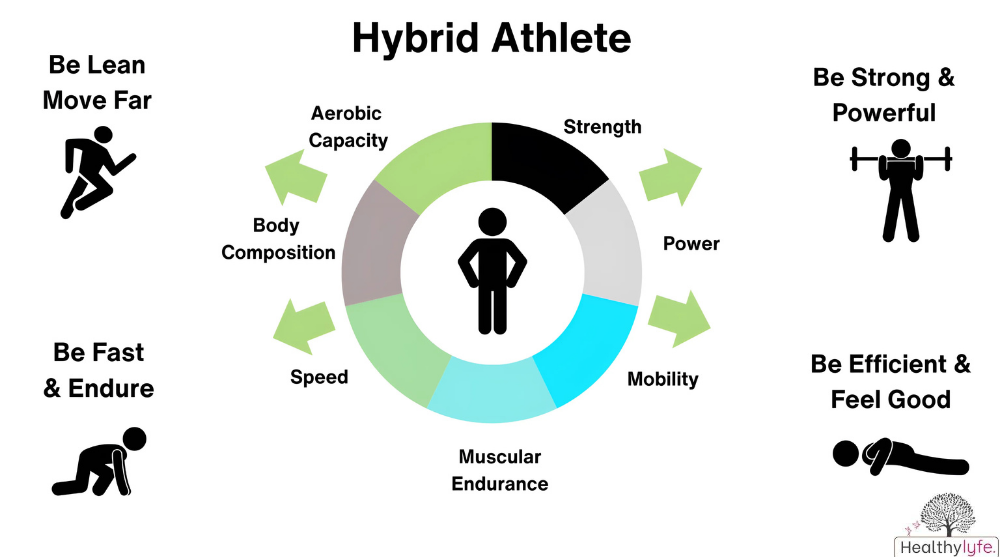
Balanced Variety
Hybrid Training mixes exercises like strength training, cardio, flexibility, and functional movements to ensure you work on all aspects of fitness. This variety helps improve overall health and fitness.
Customization
Everyone has different fitness goals and needs. Hybrid Training lets you customize your workouts to fit what works best for you—whether it’s building strength, improving endurance, or enhancing mobility.
Science and Practicality
Hybrid Training combines research-based methods with real-life exercises. It ensures your workouts are effective and safe, giving you sustainable results.
Progressive Overload
To keep improving, Hybrid Training focuses on gradually increasing the intensity and complexity of your workouts over time.
Functional Movement
Functional movements help your body perform everyday activities better. Hybrid Training includes exercises that improve mobility, balance, and coordination.
Recovery and Mind-Body Connection
Recovery is just as important as working out. Hybrid Training includes time for rest, stretching, and mental recovery to help prevent injury and promote overall well-being.
Goal-Focused Training
Whether you want to build muscle, lose weight, or increase endurance, Hybrid Training can be tailored to meet your specific goals.
Structuring a Hybrid Fitness Program
Creating a Hybrid Fitness program means combining different types of workouts to create a well-rounded and effective routine. Here’s how to set it up:
Define Your Goals
Start by identifying what you want to achieve—whether it’s building strength, improving endurance, increasing flexibility, or overall fitness.
Include Key Elements
A balanced Hybrid Fitness program includes:
- Strength Training – Building muscle and power.
- Cardio – Improving endurance and heart health.
- Functional Movement – Enhancing everyday movement and mobility.
- Flexibility and Mobility – Keeping your body flexible and injury-free.
- Recovery – Giving your body time to rest and heal.
Plan Your Weekly Routine
Structure your workouts to balance different elements, like:
- Day 1: Strength Training
- Day 2: Cardio & Functional Movement
- Day 3: Mobility & Flexibility
- Day 4: Active Recovery
- Day 5: Strength & Endurance
- Day 6: Core & Functional Work
- Day 7: Rest or Light Activity
Add Progressive Overload
Gradually increase the intensity of your workouts by lifting more weight, doing more reps, or adding more time. This helps you keep improving.
Listen to Your Body
If you feel tired or sore, give yourself extra recovery time. Flexibility is key to adapting the program based on how your body responds.
Track Your Progress
Keep track of your workouts and progress to see how you’re improving. This helps adjust your routine when needed.
Focus on Recovery
Recovery is just as important as working out. Schedule rest days, stretching, and proper nutrition to support your overall fitness journey.
Example Hybrid Fitness Workouts
Hybrid Fitness combines different types of exercises—strength, cardio, functional movements, and recovery—to create a balanced workout. Here are some simple workout ideas:
Full-Body Hybrid Workout
Workout Breakdown:
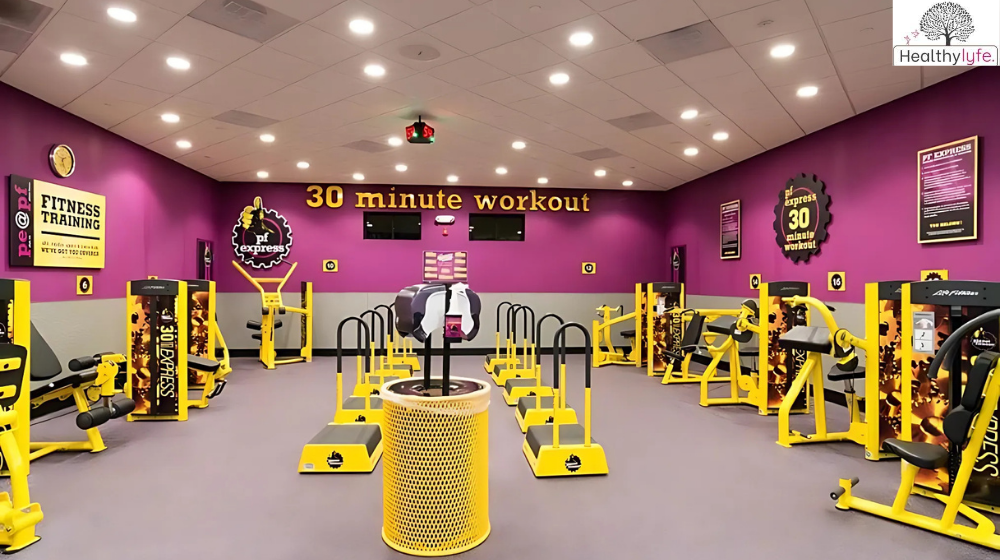
- Warm-up: 5-10 minutes light cardio and mobility exercises
- Strength: 3 sets of 10-12 reps (e.g., squats, deadlifts, push-ups)
- Cardio: 20-30 minutes moderate intensity (e.g., walking, cycling)
- Functional Movement: 3 exercises (e.g., lunges, planks, push-ups) – 3 rounds
- Cool Down: 5-10 minutes stretching or foam rolling
Strength-Focused Hybrid Workout
Workout Breakdown:
- Warm-up: Dynamic stretches, mobility drills
- Strength: 4 sets of 6-8 reps (e.g., heavy squats, deadlifts, bench press)
- Cardio: 10-15 minutes HIIT (High-Intensity Interval Training)
- Core/Functional Work: 3 exercises (e.g., planks, twists, kettlebell swings) – 3 rounds
- Recovery: Foam rolling and stretching for 10 minutes
Cardio & Mobility Hybrid Workout
Workout Breakdown:
- Warm-up: Mobility drills and dynamic stretches
- Cardio: 30 minutes steady-state (e.g., running, cycling)
- Strength/Functional: 3 rounds of bodyweight squats, push-ups, and kettlebell swings – 15 reps each
- Mobility: Stretching and yoga for 10-15 minutes
- Cool Down: Relaxation and deep breathing
Recovery-Focused Hybrid Workout
Workout Breakdown:
- Warm-up: Light movement and breathing exercises
- Flexibility & Mobility: 20 minutes of yoga or dynamic stretching
- Strength: Bodyweight exercises like lunges, push-ups – 3 rounds of 12-15 reps
- Active Recovery: Light cycling or walking for 20 minutes
- Cool Down: Deep stretching and relaxation techniques
Nutrition Tips for Hybrid Athletes
Hybrid athletes train in a mix of strength, endurance, and functional exercises. To fuel these varied workouts, here are some simple nutrition tips:
Eat a Balanced Diet
Focus on:
- Carbohydrates: For energy (e.g., whole grains, fruits, vegetables).
- Protein: For muscle repair and recovery (e.g., lean meats, eggs, legumes).
- Fats: Healthy fats for overall health (e.g., nuts, seeds, avocado).
Stay Hydrated
Drink plenty of water, especially during workouts. Electrolyte drinks can help during longer or intense sessions.
Fuel Before, During, and After Workouts
- Before Exercise: Eat a balanced meal with carbs and protein 1-2 hours before.
- During Workouts: Snacks or drinks with carbs and electrolytes can help keep energy up.
- After Workouts: Focus on protein and carbs for recovery.
Adjust Your Macronutrients
Depending on your training, adjust your carbs, protein, and fat intake.
- More protein for strength training.
- More carbs for endurance workouts.
Recovery is Key
Eat foods rich in protein and anti-inflammatory nutrients (e.g., fruits, vegetables, omega-3s) to help recovery and reduce soreness.
Listen to Your Body
Everyone’s nutrition needs are different. Pay attention to how your body responds and adjust as needed.
Snacks
Choose snacks with carbs, protein, and healthy fats, like a banana with nut butter or yogurt with fruit.
Here’s the hybrid fitness diet chart in a table format:
| Meal | Food Item | Serving Size | Calories | Macronutrients | Notes |
|---|---|---|---|---|---|
| 1. Breakfast | Oats with Chia Seeds | ½ cup oats, 1 tbsp chia seeds | ~250 kcal | Carbs, Protein, Fiber | Top with berries & almond butter |
| ½ cup almond milk, 1 tsp honey | |||||
| Snack | Boiled Egg | 1 egg | ~70 kcal | Protein | |
| Apple | 1 medium-sized | ~95 kcal | Carbs | ||
| 2. Lunch | Grilled Chicken Breast | 4-6 oz | ~200 kcal | Protein | Pair with quinoa & vegetables |
| Quinoa | 1 cup | ~220 kcal | Carbs | ||
| Steamed Broccoli | 1 cup | ~55 kcal | Fiber | ||
| Snack | Mixed Nuts | 1 handful (almonds, walnuts, etc.) | ~150 kcal | Fats | |
| Banana | 1 small | ~105 kcal | Carbs | ||
| 3. Dinner | Salmon | 4 oz | ~250 kcal | Protein, Healthy Fats | Pair with sweet potato & spinach |
| Sweet Potato | 1 medium-sized | ~130 kcal | Carbs | ||
| Sautéed Spinach | 1 cup | ~40 kcal | Fiber | ||
| Post-Workout Snack | Whey Protein Shake | 1 scoop | ~120 kcal | Protein | Add banana or sweet potato |
Common Mistakes to Avoid in Hybrid Fitness
In hybrid fitness, which combines both strength training and cardiovascular exercises, it’s important to approach the workouts thoughtfully to avoid common mistakes. Here are some key mistakes to avoid:
Overtraining
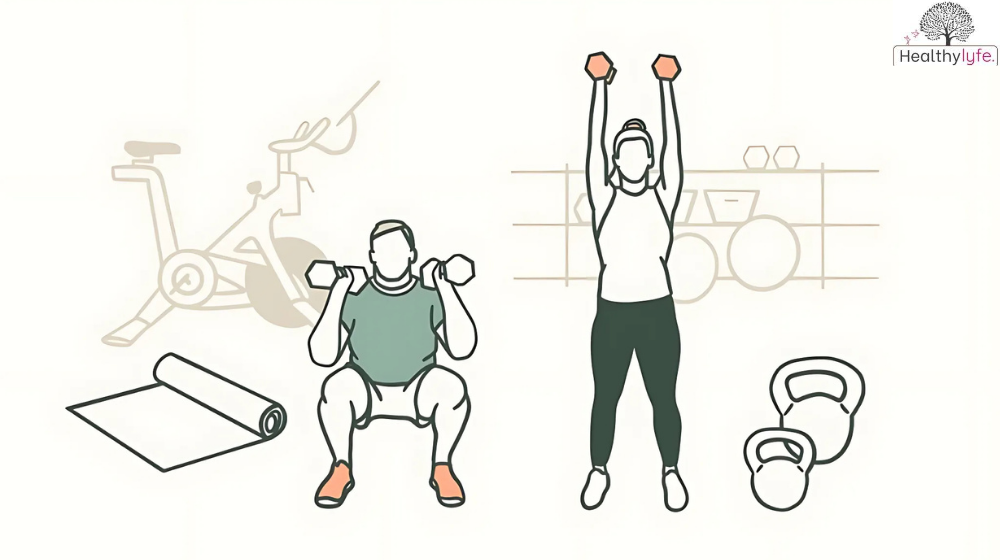
Overtraining occurs when there is an imbalance between the training load and the body’s ability to recover, leading to physical and mental fatigue, decreased performance, and increased risk of injury. Here are key aspects of overtraining and how to manage it:
Signs and Symptoms of Overtraining
- Physical Symptoms:
- Persistent muscle soreness
- Decreased strength and endurance
- Increased risk of injury
- Sleep disturbances
- Poor recovery after workouts
- Mental Symptoms:
- Lack of motivation
- Increased irritability and mood swings
- Anxiety or depression
- Decreased focus and concentration
Causes of Overtraining
- Excessive Intensity or Volume: Overloading workouts too much without adequate rest or recovery.
- Inadequate Recovery: Not allowing sufficient time for the body to repair and adapt.
- Poor Nutrition: Inadequate fueling and insufficient macronutrients (especially protein and carbs) can hinder recovery.
- Stress: High psychological stress levels can contribute to overtraining.
Prevention and Management of Overtraining
- Prioritize Recovery:
- Implement regular rest days, active recovery, and sleep to allow the body to recover.
- Include techniques such as foam rolling, stretching, and gentle yoga sessions.
- Monitor Workload:
- Gradually increase intensity and volume to avoid sudden spikes in training.
- Keep a training log to track workouts and recovery to spot patterns of overtraining early.
- Nutrition:
- Consume a balanced diet rich in macronutrients: carbohydrates for energy, protein for muscle repair, and healthy fats for hormone regulation.
- Maintain proper hydration levels.
- Stress Management:
- Incorporate stress-relieving practices such as meditation, deep breathing exercises, and relaxation techniques.
- Seek Professional Guidance:
- Consult with a fitness coach, physical therapist, or healthcare professional to create a balanced training plan tailored to individual needs.
Neglecting Nutrition
Neglecting nutrition is a common mistake that can significantly impact performance, recovery, and overall health. Proper nutrition plays a critical role in supporting fitness goals, whether they involve muscle building, fat loss, endurance, or overall wellness. Here’s why it’s important and how to avoid neglecting nutrition.
Impact of Neglecting Nutrition
- Poor Recovery: Inadequate nutrition hinders the body’s ability to recover from workouts.
- Reduced Performance: Lack of proper fuel can lead to fatigue, low energy, and decreased strength.
- Muscle Loss: Insufficient protein intake can slow muscle repair and growth.
- Hormonal Imbalances: Poor nutrition can negatively affect hormones responsible for muscle gain, metabolism, and overall health.
- Increased Risk of Injury: Poor nutrition affects joint and muscle health, making injuries more likely.
- Mental Fatigue: Malnutrition can affect brain function, leading to decreased focus and motivation.
Signs of Poor Nutrition
- Persistent fatigue
- Poor recovery
- Slow progress in fitness goals
- Mood swings or mental fog
- Frequent injuries or prolonged soreness
Key Aspects to Focus On
- Macronutrients
- Protein: Essential for muscle repair and growth. Aim for around 1.2-2.0 grams per kilogram of body weight depending on fitness goals.
- Sources: Chicken, fish, eggs, tofu, legumes, dairy, etc.
- Carbohydrates: Provide energy for workouts and recovery. Consume around 3-6 grams of carbs per kilogram of body weight.
- Sources: Rice, pasta, oats, fruits, vegetables.
- Fats: Important for hormone regulation and overall health. Focus on healthy fats like avocados, nuts, seeds, olive oil.
- Sources: Nuts, seeds, fatty fish, olive oil.
- Protein: Essential for muscle repair and growth. Aim for around 1.2-2.0 grams per kilogram of body weight depending on fitness goals.
- Micronutrients
- Adequate intake of vitamins and minerals (e.g., iron, magnesium, vitamin D) supports overall health and optimal performance.
- Hydration
- Water is critical for hydration, metabolism, and recovery. Aim for 2-3 liters per day or more depending on activity level.
- Timing of Nutrition
- Pre-workout: Consume easily digestible carbs with some protein about 1-2 hours before exercise to fuel workouts.
- Post-workout: Prioritize a mix of protein and carbs to aid recovery and replenish glycogen stores.
- Avoiding Processed Foods
- Minimize highly processed foods that lack essential nutrients and can hinder recovery and performance.
How to Avoid Neglecting Nutrition
- Meal Planning: Plan meals with balanced macronutrients in mind to ensure you’re hitting targets consistently.
- Track Nutrition: Use food journals or apps to track your intake and adjust based on performance and recovery needs.
- Consultation: Consult a nutritionist or dietitian for personalized meal plans tailored to your fitness goals.
Skipping Mobility Work
Skipping mobility work is a common mistake that can lead to poor flexibility, decreased range of motion, and increased risk of injury. Mobility work is essential for maintaining joint health, improving movement efficiency, and enhancing overall performance. Here’s why mobility is important and how to avoid skipping it.
Importance of Mobility Work
- Improved Flexibility: Enhances the ability to move joints through their full range of motion.
- Injury Prevention: Increases stability and reduces the risk of strains, sprains, and overuse injuries.
- Better Performance: Allows for smoother, more efficient movement, which improves strength and endurance.
- Faster Recovery: Enhances blood flow and helps remove metabolic waste, reducing stiffness and soreness.
Signs of Poor Mobility
- Limited range of motion during exercises or daily activities
- Difficulty performing certain movements (e.g., squats, overhead lifts)
- Muscle tightness or discomfort, especially in key areas like hips, shoulders, and lower back
- Increased injury risk due to compromised joint function
Common Areas for Mobility Work
- Hips
- Shoulders
- Thoracic Spine (upper back)
- Ankles
- Hamstrings
- Hip Flexors
Benefits of Regular Mobility Work
- Enhanced Functional Movement: Better control and efficiency in movement patterns.
- Increased Strength: Improved joint stability leads to better lifting performance.
- Reduced Stiffness: Keeps muscles and joints supple and flexible for more comfortable daily movement and exercise.
Common Mobility Exercises
- Foam Rolling: Helps release tight muscles and improve blood flow.
- Dynamic Stretching: Moves through active ranges of motion to prepare muscles and joints for activity.
- Static Stretching: Held stretches for improving flexibility and relieving muscle tightness.
- Yoga/Pilates: Focuses on full-body mobility, breathing, and controlled movements.
- Joint Circles: Circular movements to improve joint mobility in various planes.
How to Incorporate Mobility Work
- Pre-Workout: Perform dynamic stretches or mobility exercises to warm up and prepare joints for movement.
- Post-Workout: Use static stretching and foam rolling to reduce muscle tightness and improve recovery.
- Throughout the Day: Include mobility work as part of your daily routine, especially if sitting or sedentary for long periods.
- Consistency: Incorporate mobility exercises 2-3 times per week for long-term benefits.
Avoid Skipping Mobility Work
Neglecting mobility can lead to performance plateaus and injuries. Prioritizing mobility work will improve overall movement quality, recovery, and long-term fitness progress.
Conclusion
Hybrid fitness is a comprehensive approach that combines both strength training and cardiovascular exercises to create a well-rounded and adaptable fitness routine. By integrating these two components, individuals can enhance their overall physical health, athletic performance, and mental well-being. This method offers a balance between building muscle and improving endurance, helping to reduce the risk of injury by promoting mobility, flexibility, and functional movement. Additionally, hybrid fitness provides versatility, allowing for a variety of exercises that keep workouts engaging and tailored to different fitness goals. To maximize the benefits, it is important to avoid common mistakes such as overtraining, neglecting proper nutrition, skipping mobility work, and failing to track progress.
FAQs about Hybrid Fitness
What is hybrid fitness?
Hybrid fitness combines multiple training disciplines, such as weightlifting, running, yoga, and HIIT, to create a balanced fitness program.
Who is hybrid fitness for?
It’s suitable for anyone, from beginners to advanced athletes, who want to improve overall performance and avoid monotony in training.
What are the benefits of hybrid fitness?
Hybrid fitness improves strength, cardiovascular endurance, flexibility, and coordination while preventing burnout and injury from repetitive routines.
Can beginners try hybrid fitness?
Yes! Beginners can start with lighter workouts and gradually add complexity and intensity.
Do I need special equipment for hybrid fitness?
Basic equipment like dumbbells, kettlebells, a yoga mat, and resistance bands can be helpful, but many exercises rely on body weight.
What types of exercises are included in hybrid fitness?
A hybrid program often includes strength training, cardiovascular workouts, mobility exercises, and sometimes elements of functional training.
What’s the difference between hybrid fitness and cross-training?
Cross-training focuses on complementing a primary sport or goal, while hybrid fitness emphasizes creating a balanced, multi-faceted workout program.
Can I focus on specific goals like muscle building or weight loss in a hybrid plan?
Yes, you can customize a hybrid plan to prioritize goals like fat loss, muscle gain, or improved endurance while maintaining overall balance.
How often should I train in a hybrid fitness program?
Training 3-5 times a week, alternating focus areas (strength, cardio, recovery), is common.
How long should hybrid fitness workouts be?
Sessions typically range from 30-60 minutes, depending on intensity and focus.
Can hybrid fitness help prevent injuries?
Yes, incorporating diverse movements strengthens weak areas and reduces overuse injuries.
How do I avoid overtraining in hybrid fitness?
Prioritize recovery, listen to your body, and balance intense days with lighter or rest days.
Can hybrid fitness help with recovery or rehab?
Yes, it often includes mobility and flexibility work, which can aid recovery and injury prevention.
What’s the role of flexibility and mobility in hybrid fitness?
These aspects enhance performance, improve posture, and reduce injury risk.
Is hybrid fitness safe for older adults?
Absolutely! It can be tailored to suit any age or fitness level.
What’s the best diet for hybrid fitness?
A balanced diet rich in protein, carbs, and healthy fats fuels the varied training demands of hybrid fitness.
How does hybrid fitness impact mental health?
Supplements like protein powder, electrolytes, and recovery aids can be useful but aren’t mandatory.
How does hybrid fitness impact mental health?
The variety in workouts prevents boredom, reduces stress, and keeps you motivated.
How can I track progress in hybrid fitness?
Use metrics like improved strength, endurance, mobility, or even energy levels and recovery times.
Can hybrid fitness prepare me for specific sports or events?
Yes, it builds a strong foundation for performance in sports, obstacle courses, marathons, or other challenges.
By healthylyfe


